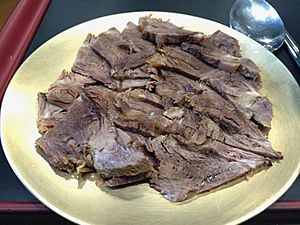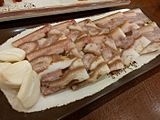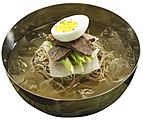Pyeonyuk facts for kids

Beef pyeonyuk
|
|
| Place of origin | Korea |
|---|---|
| Associated national cuisine | Korean cuisine |
| Serving temperature | 15–25 °C (59–77 °F) |
| Main ingredients | Beef (like brisket or tongue) or pork (belly or trotters) |
| 42.5 kcal (178 kJ) | |
| Korean name | |
| Hangul |
편육
|
|---|---|
| Hanja |
片肉
|
| Revised Romanization | pyeonyuk |
| McCune–Reischauer | p'yŏnyuk |
| IPA | [pʰjʌ.njuk̚] |
Pyeonyuk (편육; 片肉) is a traditional Korean dish. It's made from meat that has been boiled until it's very tender, then pressed and sliced into thin pieces. You can make pyeonyuk using either beef or pork.
This dish is often eaten as anju, which means it's a snack or side dish served with drinks. It's also used as a yummy topping for other Korean foods. For example, it goes well on naengmyeon (cold noodles) or seolleongtang (a type of ox bone soup). Long ago, pyeonyuk was often made when people prepared a lot of beef broth for big parties or special meals. Today, it's even used in new ways, like a cold cut in sandwiches. Many people think it's a healthier choice compared to meat that is deep-fried or stir-fried.
How Pyeonyuk is Made
To make pyeonyuk, different parts of the animal are used. For beef pyeonyuk, people often use cuts like brisket, plate, foreshank, or even tongue. For pork pyeonyuk, belly or parts of the pig's head are common choices.
First, the meat is soaked in cold water. This helps to remove any blood. Then, the whole piece of meat is boiled until it becomes very soft and tender. The water used for boiling the meat is seasoned to give it flavor. People might add salt, doenjang (a type of soybean paste), soju (a Korean drink), or cheongju (rice wine). Sometimes, black peppercorns or even a little coffee powder are added! If you're making beef pyeonyuk, green onions and whole garlic cloves are often put in the broth. For pork pyeonyuk, sliced ginger is a popular addition.
After the meat is cooked and tender, it's wrapped in a cloth. Then, a heavy weight is placed on top of it to press it down. This pressing helps the meat become firm and easy to slice very thinly.
How to Enjoy Pyeonyuk
Once the pyeonyuk is ready, it's sliced thin and served with a dipping sauce. For beef pyeonyuk, a common sauce is cho-ganjang, which is a mix of soy sauce and vinegar. Another option is gyeoja-chojang, made from soy sauce, vinegar, and mustard.
If you're eating pork pyeonyuk, it's often dipped in saeu-jeot, which are tiny salted shrimps. Pork pyeonyuk can also be enjoyed as a ssam (wrap). This means you wrap the meat in a leaf, like lettuce or perilla leaves, often with some baechu-kimchi (cabbage kimchi).
Some popular side dishes that go well with pyeonyuk include geotjeori (fresh kimchi) or spicy salads made with dried radish or other vegetables. Remember, pyeonyuk is also a great topping for cold noodles like naengmyeon or warm soups like seolleongtang.
Gallery
-
Dwaeji-meori-pyeonyuk (pressed boiled pork head slices) served with garlic
-
Naengmyeon (cold noodles) topped with boiled egg, pyeonyuk, cucumber, and pickled radish




